Delphi Filmpalast am Zoo | Read more at in70mm.com The 70mm Newsletter |
| Written by: Gerhard Witte, Berlin | Date: 27.02.2011 |
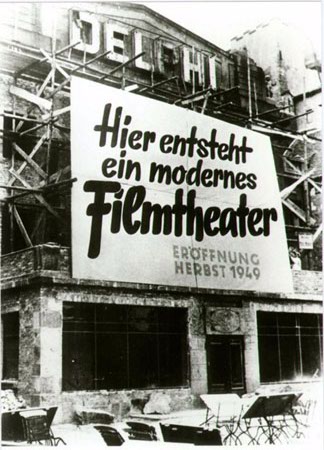 A birthplace for modern cinema. Opening: Fall of 1949.
Picture kindly provided by the Delphi Filmpalast. A birthplace for modern cinema. Opening: Fall of 1949.
Picture kindly provided by the Delphi Filmpalast.After the Second World War, a new beginning. This was once the home of the famous Delphi Palais dance hall. In 1949, Berliners greeted the opening of a large new cinema with great fanfare. | More in 70mm reading: Der „Delphi Filmpalast am Zoo“ Gallery: Delphi Filmpalast am Zoo The Grindel Filmtheater The "Savoy" in Hamburg 3D in the mid 60s in Europe with Hi-Fi Stereo 70 3D IMAX 70mm today The Shoes Of The Fisherman Internet link: Delphi Filmpalast Delphi Filmtheater Betriebs GmbH Kantstr.12a 10623 Berlin Vertreten durch den Geschäftsführer Georg Kloster Eingetragen im Amtsgericht Berlin-Charlottenburg: HRB 23630 Telefon: 030 / 312 10 26 Telefax: 030 / 312 10 27 E-Mail: info [@] delphi-filmpalast.de |
History | |
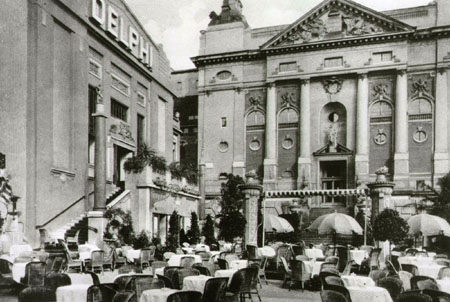 To the left, the former Delphi Palais dance hall with
its cafe terrace in the front before it was destroyed in the war.
In the background, the Theater des Westens with its centre staircase or
so called Kaisertreppe. To the left, the former Delphi Palais dance hall with
its cafe terrace in the front before it was destroyed in the war.
In the background, the Theater des Westens with its centre staircase or
so called Kaisertreppe. In 1927/1928, the Delphi Palais dance hall was built at the Kantstraße 12a site under the supervision of architect Bernhard Sehring (1 June 1855 - 27 December 1941). Mr. Sehring is also the designer of the famous Theater des Westens adjoining to the right side of the building and which was built many years prior (1895 - 1896). | |
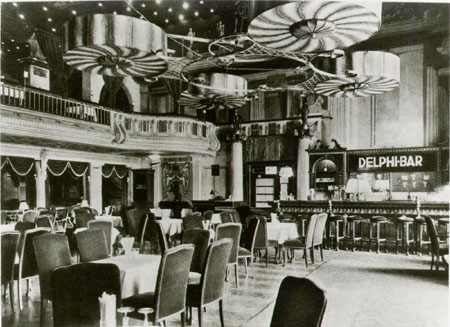 Part of the interior. Pictures kindly
provided by the Delphi Filmpalast. Part of the interior. Pictures kindly
provided by the Delphi Filmpalast.In the early 1930s, the Palais became the famous “swing mecca on Kantstraße”, one of the most popular dance locales in Berlin which often had to be closed due to overcrowding. It was here that Teddy Stauffer and his Original Teddies, the Orchester Fud Candrix from Belgium and Max Rumpf performed during what was the golden era of dance orchestra. | |
Cinema
founder Walter Jonigkeit: A brief history of
his career
| |
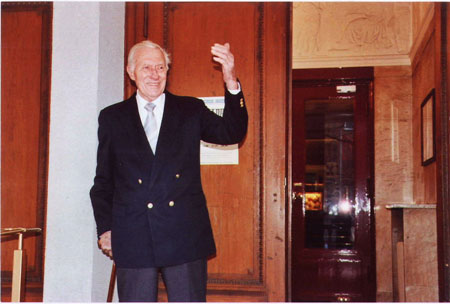 Picture kindly provided by Renate Jonigkeit. Picture kindly provided by Renate Jonigkeit.
“The most important thing in life is to accomplish something,” was Mr. Jonigkeit’s motto and one he certainly lived up to in his own life. He was both Berlin’s youngest and oldest cinema operator at the same time – a pioneer of cinema and a man nearly as old as cinema itself. A Berliner by birth, at just 18 years of age he began work volunteering at the Trianon film production company at Potsdamer Platz. In December of 1932, at the young age of 25, he took over management of the first cinema, Kamera unter den Linden, located in the city’s cultural centre, a beautiful, stucco-emblazoned hall with seating for 300, located at Unter den Linden 51. It already was the time of the beginning of sound film. | |
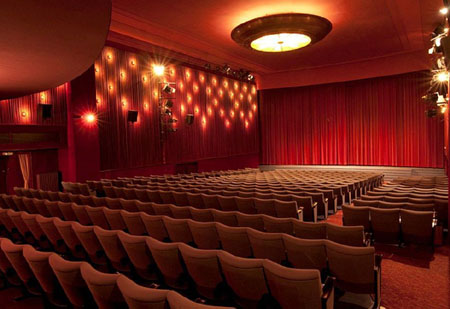 The
gigantic chandelier hanging from the ceiling weighs 2 tons. Pictures
kindly provided by the Delphi Filmpalast. The
gigantic chandelier hanging from the ceiling weighs 2 tons. Pictures
kindly provided by the Delphi Filmpalast.Under his management, it developed to become Berlin’s first arthouse cinema, a place of high film that also housed a gorgeous old Wurlitzer organ. Walter Jonigkeit was ahead of his time. He was the first to have printed programmes and catered to the wishes of cinema patrons with a repertoire that included revivals and films in their original version. The location also hosted the first film weeks dedicated to certain prominent personages in film. He used rooms above the cinema to establish the Klub der Kamerafreunde (Club for Friends of the Camera), which developed to become a meeting point for film stars of the day. Legend has it that Emil Jannings, Marianne Hoppe or even Heinrich George slipped in among the surprised cinema patrons from time to time under the guise of ticket takers or ushers. In 1937, Mr. Jonigkeit also took over management of Berlin’s first talking film-only cinema, which opened in 1934, Die Kurbel (with 576 seats), then located at Giesebrechtstraße 4. | |
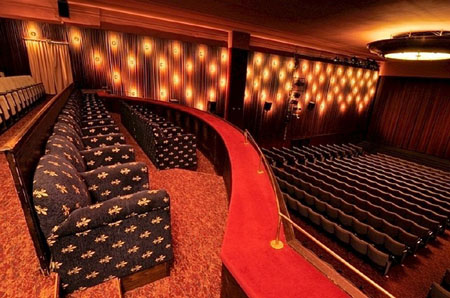 View
from the balcony. Picture kindly provided by the Delphi Filmpalast. View
from the balcony. Picture kindly provided by the Delphi Filmpalast.Unfortunately, his Kamera unter den Linden cinema was completely destroyed in the war (1943). Because Die Kurbel luckily sustained relatively little damage by the end of the war; it was the second cinema to resume showing films in 1945 after the war, the Marmorhaus on Kurfürstendamm being the first. Because there were only very few films available at the time, many Russian films without subtitles were shown, some of which Walter Jonigkeit retrieved personally, biking his way along the narrow paths through the rubble to the Russian commander’s office in the Berlin district of Lichtenberg. Cinema was a form of distraction during the difficult post-war period and language thus often played only an ancillary role. Later after the city was divided into sectors, English and old German films began to be shown again. | |
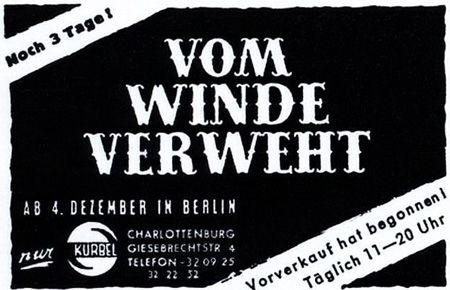 Premiered on 4 December 1953 at Die Kurbel,
"Gone with the
Wind" (USA 1939) marked an incredible success with its continuous run of
two years and four months – a record for the film in Germany, which at
the time afforded Walter Jonigkeit invitations to Hollywood. As a
result, he gained access to all of the great films and stars who flew in
just to attend the gala premieres. In the early 70s, there was a big
cinema crisis in Germany, which caused such great distress for Mr.
Jonigkeit that he had to part with the cinema in 1973. Die Kurbel closed
forever on 21 December 2011. The last picture show of course was Victor
Fleming`s south state epic "Gone with the Wind" (USA 1939). Premiered on 4 December 1953 at Die Kurbel,
"Gone with the
Wind" (USA 1939) marked an incredible success with its continuous run of
two years and four months – a record for the film in Germany, which at
the time afforded Walter Jonigkeit invitations to Hollywood. As a
result, he gained access to all of the great films and stars who flew in
just to attend the gala premieres. In the early 70s, there was a big
cinema crisis in Germany, which caused such great distress for Mr.
Jonigkeit that he had to part with the cinema in 1973. Die Kurbel closed
forever on 21 December 2011. The last picture show of course was Victor
Fleming`s south state epic "Gone with the Wind" (USA 1939). | |
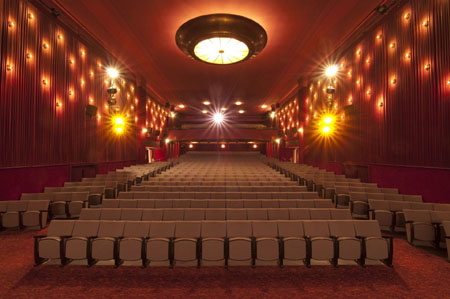 The
cinema hall after further renovations with a total of 784 seats.
Parquet: 563 seats, 28 rows, Gallery: 221 seats, 10 rows. The
cinema hall after further renovations with a total of 784 seats.
Parquet: 563 seats, 28 rows, Gallery: 221 seats, 10 rows. Mr. Jonigkeit’s main abode was his beloved Delphi Filmpalast. He continued to sit at his desk there nearly every day even at the proud age of 100. From here he also managed other cinemas in other cities such as the "Savoy" in Hamburg (Europe’s first purpose built Todd-AO cinema), the City-Palast (Cinerama/Todd-AO cinema in Munich) as well as other cinemas in Munich. From 1956 to 1959 he ran the “largest open-air cinema in the world”, the Berliner Waldbühne, which seated over 22,000 at the time. | |
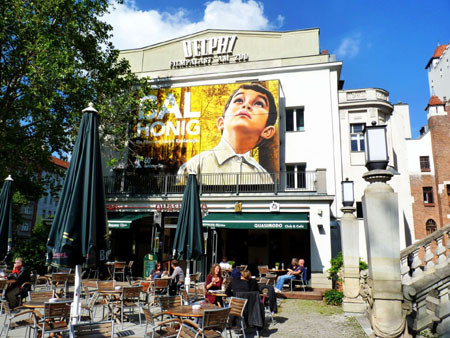 The
Delphi cinema on a sunny day. The first steps of the so called
Kaisertreppe (Kaiser’s staircase) reconstructed in 1999 are just barely
visible at the right in this picture. The
Delphi cinema on a sunny day. The first steps of the so called
Kaisertreppe (Kaiser’s staircase) reconstructed in 1999 are just barely
visible at the right in this picture. Walter Jonigkeit was a slim, good-looking, 1.90 meter-tall man with a great sense of humour. A pragmatist, entertainer and ardent lawn hockey player. He was a master of joke telling and even if his own laughter prevented him from finishing a joke, he himself was usually able to bring people to laughter. On 2 February 1988, he was awarded the Federal Republic of Germany’s Verdienstkreuz am Bande to honour his outstanding achievements in the film industry. He passed away peacefully in his sleep at the advanced age of 102. His much younger wife, whom he met one day at Die Kurbel and to whom he was married for over 50 years, wrote in a poem: | |
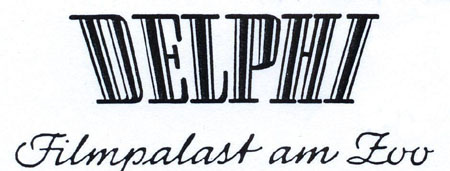 „…he
was like a butterfly, so care-free for his age. He never looked back. He
took a sip from many a cup, here and there. Now he’s had his fill, and
gone on his way.” „…he
was like a butterfly, so care-free for his age. He never looked back. He
took a sip from many a cup, here and there. Now he’s had his fill, and
gone on his way.”When loyalty is a pleasure, you have found real love. The same could certainly be said for Walter Jonigkeit’s relationship to his “child”, the Berlin Delphi Filmpalast am Zoo and to film in general. Without his work, the cinema would not exist today. | |
The opening | |
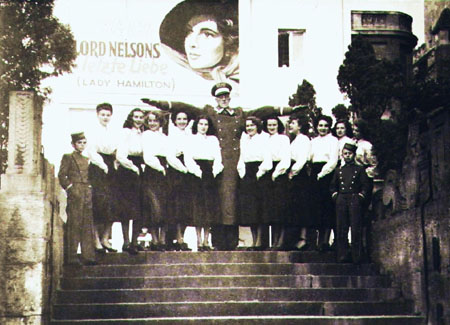 11 charming
ushers, one 2.14-meter giant doorman in livery and two pages to receive
guests attending the film premiere. Picture kindly provided by the
Delphi Filmpalast. 11 charming
ushers, one 2.14-meter giant doorman in livery and two pages to receive
guests attending the film premiere. Picture kindly provided by the
Delphi Filmpalast.
Berlin lay in ruins. It was time of chaos and Walter Jonigkeit wanted the building of a premiere cinema to be his contribution to rebuilding the city. Berlin’s governing mayor at the time, Ernst Reuter, had his office near the construction site and one day asked in Berlin dialect: “Well, my boy, what do you need?” Jonigkeit answered, “Practically everything!” Ernst Reuter helped with the cement and stone. Under the supervision of architects Brader & Bruggenhagen, the old Delphi Palais, of which only four outer walls remained standing, was rebuilt as a large cinema. At the time, Mr. Jonigkeit received a 25-year lease for the building. After two years of construction, it was finally time. The festive opening premiere took place on 3 November 1949 and was attended by representatives from the British forces occupying the city at the time. |
|
Historical timeline | |
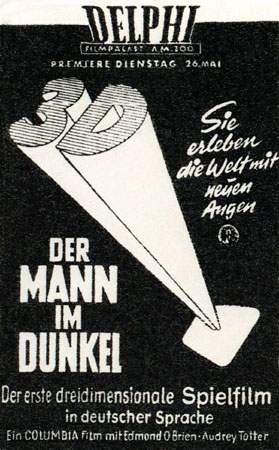 Advertisement dated 24 May 1953 from the author’s
collection. Advertisement dated 24 May 1953 from the author’s
collection.A cinema of this magnitude with the most modern of technical accoutrements at the time and seating for 1169 was certainly quite special in post-war Berlin. Walter Jonigkeit settled for nothing but the best: even in the case of the ushers, only the most beautiful girls – in tailor-fit clothing of course – came into question. Mr. Jonigkeit always embraced technical innovations as well. On 26 May 1953, a German-language 3D film entitled "Der Mann im Dunkel" ("Man in the Dark", USA 1953, Columbia Dual-Strip 3D, Naturalvision, in sepia tone) was shown here for the first time using the polarisation method, at the time the only cinema in Berlin able to change film reels without film-interruption. In order to achieve this, two new Bauer B12 projectors were installed in the projection room in addition to the two existing Ernemann projectors. In early 1955, renovations were undertaken to implement the CinemaScope screening technology. Prior to this, the film "The Robe" (USA 1953) premiered on 26 February 1954 in CinemaScope for the first time at the Filmbühne Wien located on Kurfürstendamm in Berlin. The film ran there for 12 weeks and with great success. The new wide screen system was a success story at the time. By 30 November 1954, 54 of the 251 Berlin cinemas had already been converted to CinemaScope or were scheduled for the conversion (source: Berliner Filmblätter). | Gallery: Delphi Filmpalast am Zoo |
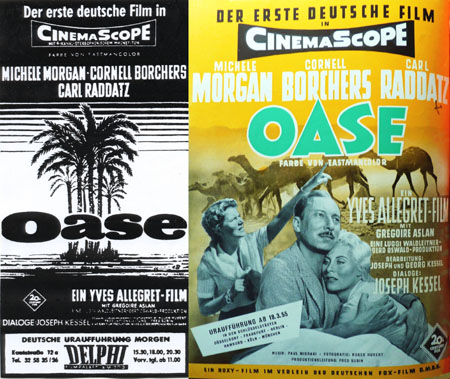 Advertisement
from 21 March 1955 and advertising for Oasis from the author’s
collection. The film was also presented in 4-channel stereophonic
magnetic sound. Advertisement
from 21 March 1955 and advertising for Oasis from the author’s
collection. The film was also presented in 4-channel stereophonic
magnetic sound. "Oase" ("Oasis", GER, FRA 1955) was the name of the first CinemaScope film screened at the Delphi, an international Luggi Waldleitner coproduction with Michèle Morgan and Carl Raddatz. In 1951 Mr. Waldleitner (1913-1998) founded Roxy-Film GmbH in Munich. The film premiered on 22 March 1955 and was also the first German CinemaScope film. | |
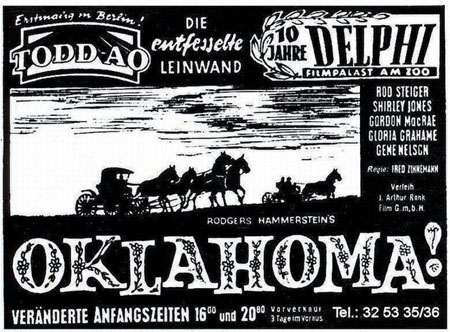 Todd-AO as a gift to the 10 year
anniversary. Advertisement from the author’s collection. Todd-AO as a gift to the 10 year
anniversary. Advertisement from the author’s collection.The new, more powerful Todd-AO widescreen technology came to Berlin in 1959. Thanks to Walter Jonigkeit, the Delphi was the first cinema to receive the improvement. Two new Bauer U2 projectors for showing films in the 70mm wide screen format were installed in the projection room. On 3 November 1959, for the 10 year anniversary of the Palast, the film "Oklahoma!" (USA 1955) was ceremoniously screened on a new, slightly curved big screen (15 x 7 meters) in combination with a new 6-channel magnetic sound system. | |
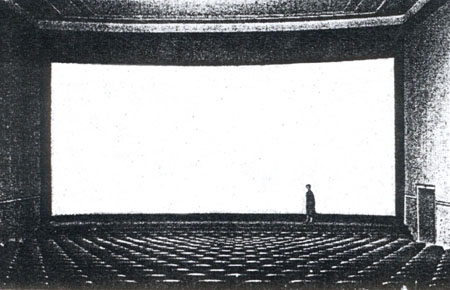 The Todd-AO big screen of the Delphi Filmpalast. Picture from the
author’s collection. The Todd-AO big screen of the Delphi Filmpalast. Picture from the
author’s collection. The cinema progressed to become a record-breaker with film runs that cinema operators could only dream of. A few examples: "The Bridge on the River Kwai" (GBR,USA 1957) 41 weeks / "Ben Hur" (USA 1959) 50 weeks / "Porgy and Bess" (USA 1959) 33 weeks / "One, Two, Three" (USA 1961) 43 weeks / "Lawrence of Arabia" (GBR 1962) 36 weeks and "My Fair Lady" (USA 1964) 52 weeks. | |
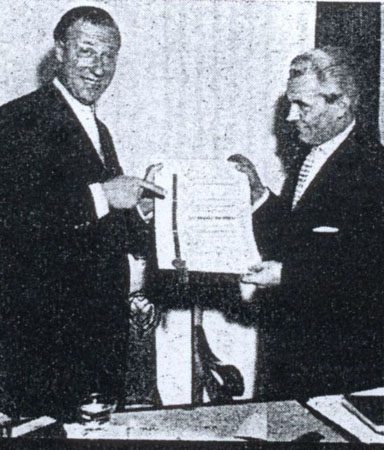 For 41 whole weeks the “River Kwai”
march roared from the speakers of the Delphi Palast in Berlin. To
recognise the remarkably long run for a first-run cinema, Walter
Jonigkeit was awarded an honour in 1958 from the acting director of
Columbia-Verleih at the time, thanking Mr. Jonigkeit for his outstanding
showmanship, exemplary support and diligent care for the use of the
film. Picture from the author’s collection. For 41 whole weeks the “River Kwai”
march roared from the speakers of the Delphi Palast in Berlin. To
recognise the remarkably long run for a first-run cinema, Walter
Jonigkeit was awarded an honour in 1958 from the acting director of
Columbia-Verleih at the time, thanking Mr. Jonigkeit for his outstanding
showmanship, exemplary support and diligent care for the use of the
film. Picture from the author’s collection.Later there were times of crisis as well such as when competition began to grow in the form of new chain operations and newly built film complexes immediately nearby on Kurfürstendamm. Mr. Jonigkeit and his independent establishment could no longer keep up with the grand premieres. And then the big crisis in cinema during the late 60s and early 70s. The large cinemas were divided up into several smaller cinemas. Not so for the Delphi Filmpalast. The great wave of sex education films at the time was a lifesaver for cinema. The films of Oswalt Kolle such as "Das Wunder der Liebe" ("The Miracle of Love", FRG 1968) or the numerous films of the Schulmädchen-Report ("The School Girls", FRG from 1970) series attracted millions of interested filmgoers to the cinemas. At Die Kurbel cinema there was even a seating plan that strictly separated men and women from sitting together. Today we can only chuckle at the thought. After the cinema’s 25-year lease expired, Mr. Jonigkeit only received temporary contracts and the district authorities in Berlin-Charlottenburg, which now owned the property, began considering whether to close the cinema for good. | |
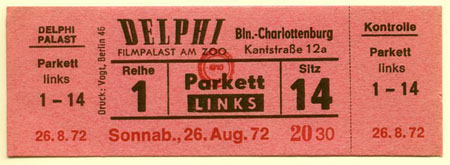 In
1980, the “market leader”, the Zoo-Palast located right nearby, wanted
to take over the cinema. Proprietors of Berlin’s OFF cinemas were
outraged by the idea and successfully joined forces to prevent it. Over
the years, a lively cultural scene has found a home in the spaces
underneath the cinema. For instance, the popular Quasimodo club for live
events still exists today. The club was founded in 1975 by the
Italian-born Giorgio Carioti who also took over the cafe and garden
terrace on the front side of the building on Kantstraße in the early
90s. Or the Vagantenbühne, which was founded in 1949 as a private
basement theatre. In 1981 the cinema was renovated and the number of
seats was reduced to a comfortable 725. For the Berlin International
Film Festival, the Forum of New Cinema (Das Forum des jungen Films)
moved to the Delphi Filmpalast the same year. The establishment slowly
developed to become an arthouse cinema. In 1984 two additional acting
partners joined up: Claus Boje, film producer and founder of Delphi
Filmverleih GmbH and Georg Kloster, executive director of
York-Kinogruppe in Berlin. Berlin’s Senator of Culture at the time,
Volker Hassemer, spotted the value of the ensemble and fortunately
arranged a new long-term lease for the cinema during the mid-80s. In
1980, the “market leader”, the Zoo-Palast located right nearby, wanted
to take over the cinema. Proprietors of Berlin’s OFF cinemas were
outraged by the idea and successfully joined forces to prevent it. Over
the years, a lively cultural scene has found a home in the spaces
underneath the cinema. For instance, the popular Quasimodo club for live
events still exists today. The club was founded in 1975 by the
Italian-born Giorgio Carioti who also took over the cafe and garden
terrace on the front side of the building on Kantstraße in the early
90s. Or the Vagantenbühne, which was founded in 1949 as a private
basement theatre. In 1981 the cinema was renovated and the number of
seats was reduced to a comfortable 725. For the Berlin International
Film Festival, the Forum of New Cinema (Das Forum des jungen Films)
moved to the Delphi Filmpalast the same year. The establishment slowly
developed to become an arthouse cinema. In 1984 two additional acting
partners joined up: Claus Boje, film producer and founder of Delphi
Filmverleih GmbH and Georg Kloster, executive director of
York-Kinogruppe in Berlin. Berlin’s Senator of Culture at the time,
Volker Hassemer, spotted the value of the ensemble and fortunately
arranged a new long-term lease for the cinema during the mid-80s. | |
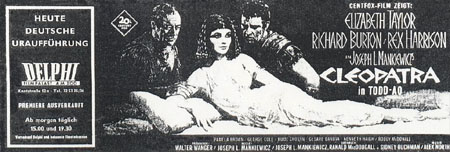 Advertisement dated 24 October
1963 from the author’s collection. Advertisement dated 24 October
1963 from the author’s collection. For the festive premier of the grand production "Cleopatra" (GBR/USA 1963) on 24 October 1963, Walter Jonigkeit hired students and dressed them up in Roman costumes. In the evenings, they stood holding burning torches in front of the cordons of the Delphi Filmpalast. At one point a tree caught fire, requiring the fire brigade to be called in giving the film great publicity at the time. | |
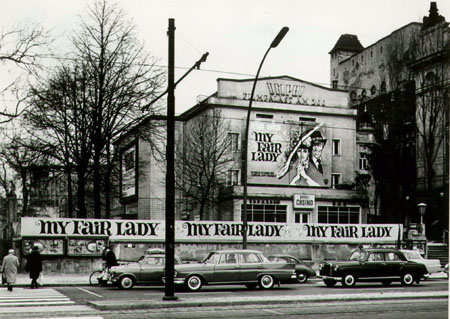 Audrey Hepburn as Eliza Doolittle in My Fair Lady
(USA 1964), premiere festivities on 23 December 1964, brought Berliners
52 weeks of cinematic delight at the cinema on Kantstrasse. Picture
kindly provided by the Delphi Filmpalast. Audrey Hepburn as Eliza Doolittle in My Fair Lady
(USA 1964), premiere festivities on 23 December 1964, brought Berliners
52 weeks of cinematic delight at the cinema on Kantstrasse. Picture
kindly provided by the Delphi Filmpalast.At the adjacent Theater des Westens the German stage version of "My Fair Lady" with Karin Hübner and Paul Hubschmid previously ran with incredible success two years long, premiered October 1961. | |
Second Berlin International Film Festival held 12 –
25 June 1952
| |
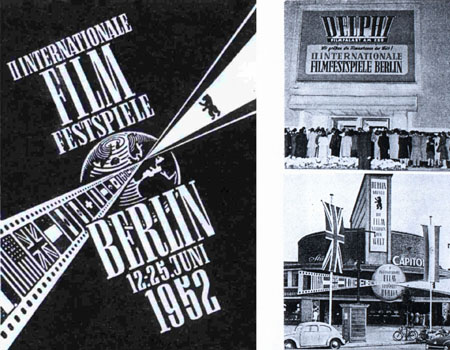 Pictures from the author’s collection. Pictures from the author’s collection.The two main festival halls for the second Berlin International Film Festival in 1952 were the Delphi Filmpalast am Zoo and the Capitol located at Lehniner Platz on the north side of Kurfürstendamm. The cinema was renovated seven years later to become Germany’s first Cinerama cinema equipped with 915 seats. The German premiere of the film "This is Cinerama" took place on 29 April 1959. Just prior to this on 3 April, Berliners sailed the high seas for the first time with the Norwegian training ship Christian Radich in the Cinemiracle film "Windjammer" at the Berliner Sportpalast, a multi-purpose function hall. The built-in cinema had 2500 seats (source: Berliner Filmblätter). | Gallery: Delphi Filmpalast am Zoo |
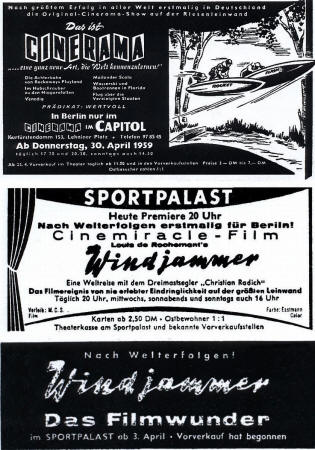 Advertisements
from the author`s collection. Advertisements
from the author`s collection.Click the image to see enlargement The first Berlin International Film Festival took place from 6 – 18 June 1951. At the time, the festival hall was at the Titania Palast (1920 seats), which sustained only minor damages in the war and located on Schloßstraße in the Berlin district of Steglitz. From 1953 to 1956 the two main locations for the festival were the Filmbühne Wien (previously the Union-Palast) which was restored after being destroyed in the war and the new built Gloria Palast opened 2 January 1953. Both film screening locations were located on Kurfürstendamm. Beginning in 1957 the Zoo Palast, also a newly built cinema right near the Kaiser Wilhelm Memorial Church, became the host for the festival and subsequently the new focal point for the Berlinale. Awards, 1952: Golden Berliner Bear: "Hon dansade en sommar" ("One Summer of Happiness") Silver Berliner Bear: "Fanfan, la tulipe" ("Fan-Fan the Tulip") Bronze Berliner Bear: "Cry the Beloved Country" | |
Honouring Walter Jonigkeit for his involvement in introducing and widespread adoption of CinemaScope projection technology. | |
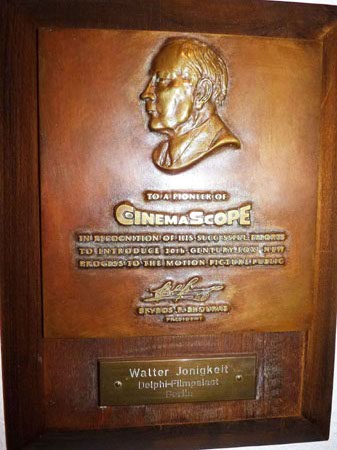 Spyros P. Skouras (28
March 1893-16 August 1971), former president of 20th Century Fox
(1942-1962), recognised Mr. Jonigkeit for his works with a commemorative
plaque in the mid-50s: “In recognition of his successful
efforts to introduce 20th Century Fox new process to the motion picture
public”. Picture from the author’s collection. Spyros P. Skouras (28
March 1893-16 August 1971), former president of 20th Century Fox
(1942-1962), recognised Mr. Jonigkeit for his works with a commemorative
plaque in the mid-50s: “In recognition of his successful
efforts to introduce 20th Century Fox new process to the motion picture
public”. Picture from the author’s collection.Over the years nearly all of the large traditional establishments on the boulevard Kurfürstendamm such as the Marmorhaus, Filmbühne Wien, Astor, MGM –Theater, Capitol, Gloria Palast and the impressive Royal-Palast on Tauentzienstraße were either demolished or gutted. Today, the venerable Delphi Filmpalast am Zoo continues to delight Berliners and is one of the city’s most gorgeous motion picture establishments – a true “old-school-cinema” screening a special selection of films. A cinema that does not sell popcorn. A cinema that can still show films in 70mm widescreen format. It is imbedded within a unique architectural mix consisting of the Theater des Westens, the Kant-Dreieck, the Hotel Savoy and the Ludwig-Erhard-Haus. Many thanks to Ingolf Vonau (Delphi Filmpalast) for his kind support. | |
Further information | |
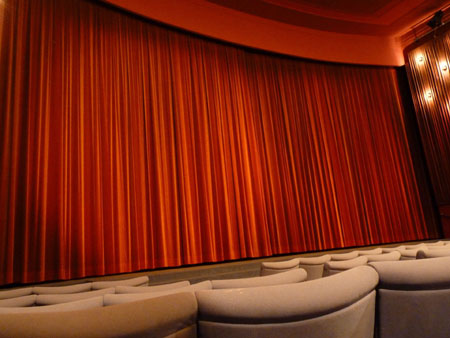 The
impressive curtain which covers a slightly curved 15 x 7 meter screen.
Picture from the author’s collection. The
impressive curtain which covers a slightly curved 15 x 7 meter screen.
Picture from the author’s collection.The Delphi Filmpalast web site A description of the Delphi Filmpalast can be found on the website of the Berliner Kinokompendium and here the cinema Die Kurbel: The association “Kinomuseum Berlin e.V.“ (Board of managers: Jean-Pierre Gutzeit, Uwe Borrmann, Joachim Kelsch) get involved in preserving, arching and maintaining the historic and ongoing cinema culture (according to the original form) Berlin International Film Festival 10 – 20 February 2011: The German premiere of "Gone with the Wind" took place on 15.01.1953 at Filmcasino in Munich. Late in the year, on 04.12.1953, the Berliners enjoyed the film at Die Kurbel for the first time. "The Robe" in CinemaScope had its premiere in Germany also on 04.12.1953 in two cinemas: at the Stachus Film Palast (Munich) and at the Metro im Schwan (Frankfurt am Main), here with a screen size of 4.70 x 12 m. I got a lot of information from the long film series booklet Berliner Filmblätter. | |
| Go: back - top -
back issues -
news index Updated 22-01-25 |
